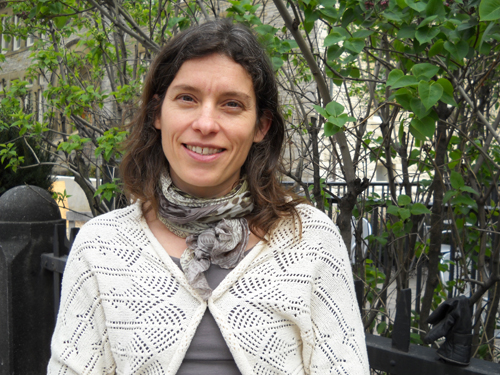
She’s a bit nervous about the fieldwork. But Jennifer Bonnell is excited about her new research project at U of G, where she began a post-doc this year on the history of beekeeping.
Through a historian’s-eye view of changes in this ageless craft, she hopes to help practitioners, scientists and environmentalists stem declines in pollinators vital to making food and protecting natural biodiversity.
Pollinators, including bees, help produce food as well as other agricultural and forestry crops. They are also integral to natural ecosystems worldwide.
Bee numbers are falling across North America. Experts have pointed to various factors, including habitat loss and monoculture farming, pesticide use, honeybee parasites and changing beekeeping practices such as trucking pollinating colonies across the continent.
Bonnell arrived in Guelph’s history department in 2011 with a two-year, $81,000 grant from the Social Sciences and Humanities Research Council. Working with Prof. Stuart McCook, she is studying beekeeping history in southern Ontario and upper New York State.
She says historians can look at big-picture changes in land use and beekeeping practices over decades.
“It’s not just changing farming practices but changing suburban land uses that interest me,” she says. Contrasting her work in environmental history and GIS mapping with scientists’ lab studies elsewhere on campus, she adds, “What I offer is a focus on a different set of sources. I can look beyond some of the statistics.”
She has already tapped into historical data about colonies, beekeepers and honey production from Canada’s farm censuses.
Using geographic information systems, she’s marrying those data with regional maps to see how landscape uses have affected beekeeping practices and populations over the past century. She’s been able to pick out the effects of a disease called American foul-brood that hit hives during the 1940s.
Bonnell expects to spend time in the U of G Library archives with the Burton Noble Gates collection. Named for an apiarist who taught at the Ontario Agricultural College in 1918-19, the collection includes annual reports and correspondence of beekeeping associations.
She also plans to talk to individual beekeepers and visit U of G’s Townsend House, home to numerous hives maintained on campus.
“I need to suit up and get up close and personal with some bees,” she says, adding that this will be her first hands-on exposure to the insects. “I’m a little bit nervous.”
Her study began where many research projects start: with curiosity and a paradox. For her PhD at the Ontario Institute for Studies in Education at the University of Toronto, she studied the environmental history of Toronto’s Don River Valley.
She had begun foraging around her new Toronto home about a decade ago by cycling alongside the Don Valley. The more she looked into its past century, the more bees – or, specifically, beekeepers – she encountered.
The valley attracted bohemian characters, both squatters and landowners alike.
Take Charles Sauriol, co-founder of the Don Valley Conservation Association. He lived with his family in the city, where he worked in advertising. But they spent summers only kilometres away in a cottage in the Don Valley from the 1920s to the ’60s.
For decades, Sauriol kept bees in the valley, where he studied plants and pollinators. In his 1983 book, A Beeman’s Journey, he wrote about “Old Murph,” a squatter who tended about 50 colonies in a bee yard in the lower Don Valley in the 1930s and ’40s. It was Murph who inspired Sauriol’s own beekeeping passion.
In turn, their stories caught Bonnell’s eye.
“It really piqued my interest – how this remnant green space in the heart of the city allowed for the persistence of these rural occupations like beekeeping.”
Finding a place where she could pursue that interest didn’t take long. “Guelph, of course, made all sorts of sense.” U of G’s history department offers strengths in rural history; last fall, Bonnell spoke about her work for the annual Rural History Roundtable.
She also hopes to work with Prof. Ernesto Guzman, School of Environmental Sciences (SES), who has studied possible causes of colony collapse disorder threatening honeybees in North America. In a 2010 study, he traced honeybee colony mortality to infections of parasitic varroa mites.
He belongs to the Canadian Pollination Initiative, launched at U of G in 2009 to help address pollinator declines. This strategic research network of some 50 scientists is funded by the Natural Sciences and Engineering Research Council and headed by retired SES professor Peter Kevan.
Bonnell says she believes lots of people share a fascination with bees, from their communal societies to their communication methods to their legendary – if anthropomorphized – status as industrious and beneficial insects.
“Bees are something people care deeply about. But they are neither fully domesticated nor fully wild. What they find, and don’t find, on their foraging flights is a source of increasing concern.”